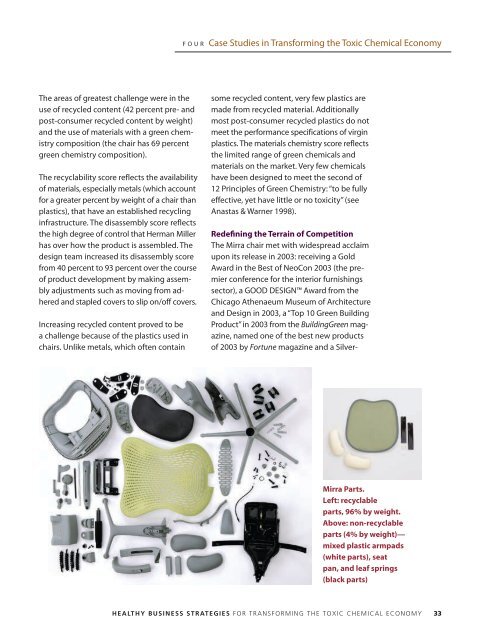Healthy Business Strategies - Clean Production Action
Healthy Business Strategies - Clean Production Action
Healthy Business Strategies - Clean Production Action
Create successful ePaper yourself
Turn your PDF publications into a flip-book with our unique Google optimized e-Paper software.
The areas of greatest challenge were in the<br />
use of recycled content (42 percent pre- and<br />
post-consumer recycled content by weight)<br />
and the use of materials with a green chemistry<br />
composition (the chair has 69 percent<br />
green chemistry composition).<br />
The recyclability score reflects the availability<br />
of materials, especially metals (which account<br />
for a greater percent by weight of a chair than<br />
plastics), that have an established recycling<br />
infrastructure. The disassembly score reflects<br />
the high degree of control that Herman Miller<br />
has over how the product is assembled. The<br />
design team increased its disassembly score<br />
from 40 percent to 93 percent over the course<br />
of product development by making assembly<br />
adjustments such as moving from adhered<br />
and stapled covers to slip on/off covers.<br />
Increasing recycled content proved to be<br />
a challenge because of the plastics used in<br />
chairs. unlike metals, which often contain<br />
F O u R Case Studies in Transforming the Toxic Chemical Economy<br />
some recycled content, very few plastics are<br />
made from recycled material. Additionally<br />
most post-consumer recycled plastics do not<br />
meet the performance specifications of virgin<br />
plastics. The materials chemistry score reflects<br />
the limited range of green chemicals and<br />
materials on the market. very few chemicals<br />
have been designed to meet the second of<br />
12 Principles of Green Chemistry: “to be fully<br />
effective, yet have little or no toxicity” (see<br />
Anastas & Warner 1998).<br />
Redefining the Terrain of competition<br />
The Mirra chair met with widespread acclaim<br />
upon its release in 2003: receiving a Gold<br />
Award in the Best of NeoCon 2003 (the premier<br />
conference for the interior furnishings<br />
sector), a GOOD DESIGN Award from the<br />
Chicago Athenaeum Museum of Architecture<br />
and Design in 2003, a “Top 10 Green Building<br />
Product” in 2003 from the BuildingGreen magazine,<br />
named one of the best new products<br />
of 2003 by Fortune magazine and a Silver-<br />
Mirra Parts.<br />
Left: recyclable<br />
parts, 96% by weight.<br />
Above: non-recyclable<br />
parts (4% by weight)—<br />
mixed plastic armpads<br />
(white parts), seat<br />
pan, and leaf springs<br />
(black parts)<br />
healthy business strategies for transforming the toxic chemical economy


